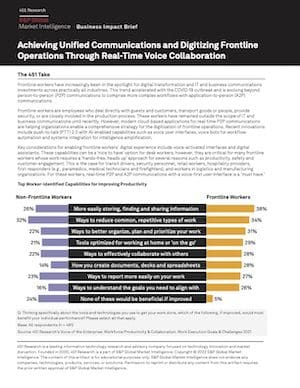451 Research Issues Business Impact Brief on the Transformative Benefits of Push-to-Talk (PTT) 2.0
S&P Global’s 451 Research, the leading analyst in topics and technologies driving digital transformation, recently issued a report on the profound impacts of digital transformation on the frontline workforce.
For many years, it’s been clear that frontline workers know they have not received the adequate tools necessary to do their jobs well. As the 451 Research brief says, “Frontline workers are employees who deal directly with guests and customers, transport goods or people, provide security, or are closely involved in the production process. These workers have remained outside the scope of IT and business communications until recently.”
Four Key Business Impacts of Unified Communications and Push-to-Talk 2.0
Frontline workers need intelligent tools that help them more easily find and share information, automate routine tasks, access information on the go, collaborate with team members, and more. As 451 Research notes, today’s enterprises must bring these capabilities together if they want to make significant strides in both near- and long-term productivity.
Push-to-Talk 2.0 meets these critical business needs and brings frontline workers into a Unified Communications strategy. Here are four key business impacts 451 Research identifies for frontline operations:
- More efficient delivery of goods and services: The digitization of frontline operations is emerging as a key priority. Enabling the frontline workforce will have a massive impact for organizations looking to adapt and remain competitive.
- Better customer service: Frontline workers require real-time access to information as they do their jobs. This includes a wide range of use cases such as accessing delivery status updates, checking product inventory, looking up product specifications or consulting subject matter experts without having to leave the customer.
- Improved productivity and safety: Voice-activated interfaces and digital assistants are among the top disruptive technologies that organizations are looking to adopt. Voice-first collaboration is particularly relevant for enabling frontline workers, given their need to keep their eyes up for productivity, customer engagement, and safety.
- Competitive advantage: Organizations benefit from real-time application-to-person communications and workflow automation integrations to back-end business systems, third-party services, sensors and devices, and voice-activated AI bots. This will result in significant near- and long-term productivity and efficiency gains and competitive advantage across nearly all industries with frontline operations.
Learn more about each benefit in 451 Research’s latest Business Impact Brief on the benefits of Unified Communications, digitizing frontline operations, and real-time voice technology.
You Might Also Like:
- Workforce Productivity and Collaboration in 2022 and Beyond
- Video: 451 Research on PTT 2.0
- Fact Sheet: Push-to-Talk 2.0
- Push-to-Talk 2.0: The Next Generation of Frontline Communication
- Video: The Orion Voice-First Intelligent Collaboration Platform
- E-book: The Future of Voice at Work
- Frontline Collaboration Solution Buyer’s Guide
- E-book: 12 Reasons Radios Are Holding Your Company Back
